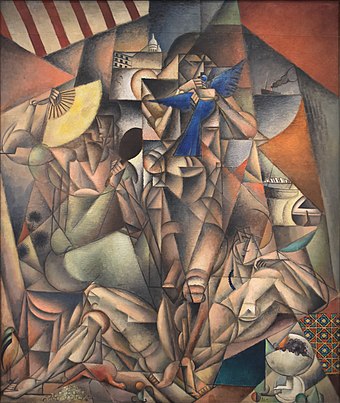L'Oiseau bleu (Metzinger)
| L'Oiseau bleu | |
|---|---|
| English: The Blue Bird | |
 |
|
| Artist | Jean Metzinger |
| Year | 1912-13 |
| Medium | Oil on canvas |
| Dimensions | 230 cm × 196 cm (90.5 in × 77.2 in) |
| Location | Musée d'Art Moderne de la Ville de Paris |
L'Oiseau bleu (also known as The Blue Bird and Der Blaue Vogel) is a large oil painting created in 1912–1913 by the French artist and theorist Jean Metzinger (1883–1956); considered by Guillaume Apollinaire and André Salmon as a founder of Cubism, along with Georges Braque and Pablo Picasso. L'Oiseau bleu, one of Metzinger's most recognizable and frequently referenced works, was first exhibited in Paris at the Salon des Indépendants in the spring of 1913 (n. 2087), several months after the publication of the first (and only) Cubist manifesto, Du «Cubisme», written by Jean Metzinger and Albert Gleizes (1912). It was subsequently exhibited at the 1913 in Berlin (titled Der blaue Vogel, n. 287). Apollinaire described L'Oiseau bleu as a 'very brilliant painting' and 'his most important work to date'. L'Oiseau bleu, acquired by the City of Paris in 1937, forms part of the permanent collection at the Musée d'Art Moderne de la Ville de Paris.
L'Oiseau bleu is an oil painting on canvas with dimensions 230 x 196 cm (90.5 by 77.2 in). The work represents three nude women in a scene that contains a wide variety of components. L'Oiseau bleu, writes Joann Moser, uses a wealth of anecdotal detail "which comprises a compendium of motifs found in earlier and later paintings by Metzinger: bathers, fan, mirror, ibis, necklace, a boat with water, foliage and an urban scene. It is a mélange of interior and exterior elements integrated into one of Metzinger's most intriguing and successful compositions."
The central standing 'foreground' figure is shown affectionately holding in both hands a blue bird (thus the title of the painting). The reclining figure wearing a necklace shown in the lower center of the canvas is placed next to a pedestal fruit bowl and another bird with the unmistakable coloration of the rare Scarlet ibis (L'Ibis rouge), a rich symbol for both exoticism and fashion. Costume designers for Parisian cabarets such as Le Lido, Folies Bergère, the Moulin Rouge and haute couture houses in Paris during the 1910s used the feathers of the scarlet Ibis in their shows and collections. The Ibis is a bird to which the ancient Egyptians paid religious worship and attributed to it a 'virgin purity'. A mysterious pyramidal shape is seen as if through a porthole to the right of the reclining figure's head, though it remains a matter of speculation whether there exists any relation to the ibis or pyramids of ancient Egypt. In front of the pyramid appears a shape that resembles a sundial, perhaps meant as the element of time, or 'duration', as the clock placed in the upper right hand corner of his Nude of 1910.
...
Wikipedia
